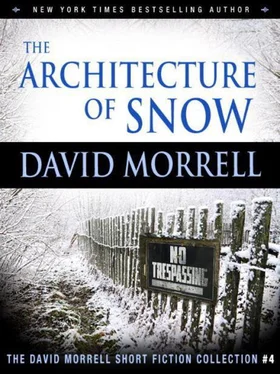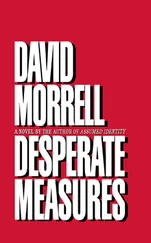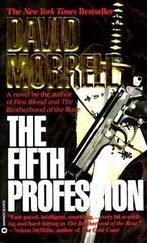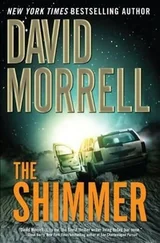David Morrell - The Architecture of Snow
Здесь есть возможность читать онлайн «David Morrell - The Architecture of Snow» весь текст электронной книги совершенно бесплатно (целиком полную версию без сокращений). В некоторых случаях можно слушать аудио, скачать через торрент в формате fb2 и присутствует краткое содержание. Жанр: Современная проза, на английском языке. Описание произведения, (предисловие) а так же отзывы посетителей доступны на портале библиотеки ЛибКат.
- Название:The Architecture of Snow
- Автор:
- Жанр:
- Год:неизвестен
- ISBN:нет данных
- Рейтинг книги:4 / 5. Голосов: 1
-
Избранное:Добавить в избранное
- Отзывы:
-
Ваша оценка:
- 80
- 1
- 2
- 3
- 4
- 5
The Architecture of Snow: краткое содержание, описание и аннотация
Предлагаем к чтению аннотацию, описание, краткое содержание или предисловие (зависит от того, что написал сам автор книги «The Architecture of Snow»). Если вы не нашли необходимую информацию о книге — напишите в комментариях, мы постараемся отыскать её.
The Architecture of Snow — читать онлайн бесплатно полную книгу (весь текст) целиком
Ниже представлен текст книги, разбитый по страницам. Система сохранения места последней прочитанной страницы, позволяет с удобством читать онлайн бесплатно книгу «The Architecture of Snow», без необходимости каждый раз заново искать на чём Вы остановились. Поставьте закладку, и сможете в любой момент перейти на страницу, на которой закончили чтение.
Интервал:
Закладка:
David Morrell
The Architecture of Snow
INTRODUCTION
Few authors had the mystique of J.D. Salinger. In the mid-1960s, having written four much-discussed books, one of which was already being treated as a classic, the revered author of The Catcher in the Rye stopped publishing and withdrew from public life.
He never explained why, but a few possibilities come to mind. His final book, a pairing of novellas, Raise High the Roof Beam, Carpenters and Seymour: An Introduction, received mixed critical reactions. Perhaps Salinger’s personality was as fragile as the name of his fictional Glass family implied. Perhaps he decided to stop exposing his work to reviewers and preferred to retreat to a simple life where he listened to “the sound of one hand clapping,” a Zen Buddhist phrase that he favored.
For whatever reason, his walled compound in the remote town of Cornish, New Hampshire, acquired the reputation of a hermit’s lair. Fans who made pilgrimages to the area reported occasional sightings of the lean, aesthetic-looking author, based on a solitary, long-ago book photograph that they had studied. But over the years, these sightings became more rare while the citizens of Cornish closed ranks, refusing to reveal the little information they had about him.
The few reports that surfaced indicate that during the next four decades Salinger wrote obsessively every day and that he had stacks of completed novels in a large safe in his home. In January of 2010, he died at the age of 91. It remains to be seen if those novels will be published. Perhaps they never existed. Perhaps he destroyed them before his death. Perhaps they’re unreadable. Or perhaps they are masterpieces, the publication of which will come as unexpectedly as his withdrawal from public life.
These thoughts intrigued me long before Salinger died. In 2004, as I considered the way publishing had changed since my debut novel, First Blood , appeared in 1972, I wondered what Salinger would make of the international conglomerates that now control the book world. Publicity has become as important as editing. Marketing is often more important than content..
How would a modern publisher react, I wondered, if-out of nowhere and after so many years-a new Salinger manuscript arrived on an editor’s desk? I called the author by another name, and the circumstances of his withdrawal are different, but anyone familiar with Salinger will recognize the inspiration for “The Architecture of Snow.”
David Morrell
THE ARCHITECTURE OF SNOW
On the first Monday in October, Samuel Carver, who was 72 and suddenly unemployed, stepped in front of a fast-moving bus. Carver was an editor for Edwin March amp; Sons, until recently one of the last privately owned publishing houses in New York.
“To describe Carver as an editor is an understatement,” I said in his eulogy. Having indirectly caused his death, March amp; Sons, now a division of Gladstone International, sent me to represent the company at his funeral. “He was a legend. To find someone with his reputation, you need to go back to the 1920s, to Maxwell Perkins and his relationships with Ernest Hemingway, F. Scott Fitzgerald, and Thomas Wolfe. It was Perkins who massaged Hemingway’s ego, helped Fitzgerald recover from hangovers, and realized that the two feet of manuscript Wolfe lugged into his office could be divided into several novels.”
Standing next to Carver’s coffin at the front of a Presbyterian church in lower Manhattan, I counted ten mourners. “Carver followed Perkins’s example,” I went on. “For much of the past five decades, he discovered an amazing number of major authors. He nurtured them through writer’s block and discouraging reviews. He lent them money. He promoted them tirelessly. He made them realize the scope of their creative powers. R. J. Wentworth’s classic about childhood and stolen innocence, The Sand Castle . Carol Fabin’s verse novel, Wagon Mound . Roger Kilpatrick’s Vietnam War novel, The Disinherited . Eventual recipients of Pulitzer Prizes, these were buried in piles of unsolicited manuscripts that Carver loved to search through.”
Ten mourners. Many of the authors Carver had championed were dead. Others had progressed to huge advances at bigger publishers and seemed to have forgotten their debt to him. A few retired editors paid their respects. Publishers Weekly sent someone who took a few notes. Carver’s wife had died seven years earlier. The couple hadn’t been able to have children. The church echoed coldly. So much for being a legend.
The official explanation was that Carver stumbled in front of the bus, but I had no doubt that he committed suicide. Despite my praise about the past five decades, he hadn’t been a creative presence since his wife’s death. Age, ill health, and grief wore him down. At the same time, the book business changed so drastically that his instincts didn’t fit. He was a lover of long shots, with the patience to give talent a chance to develop. But in the profit-obsessed climate of modern publishing, manuscripts needed to survive the focus groups of the marketing department. If the books weren’t easily promotable, they didn’t get accepted. For the past seven years, George March, the grandson of the company’s founder, loyally postponed forcing Carver into retirement, paying him a token amount to come to the office two days a week. The elderly gentleman had a desk in a corner where he studied unsolicited manuscripts. He also functioned as a corporate memory, although it was hard to imagine how stories about the good-old days could help an editor survive in contemporary publishing. Not that it mattered-I was one of the few who asked him anything.
Eventually, March amp; Sons succumbed to a conglomerate. Gladstone International hoped to strengthen its film-and-broadcast division by acquiring a publisher and ordering it to focus on novels suited for movies and television series. The trade buzzword for this is “synergy.” As usual when a conglomerate takes over a business, the first thing the new owner did was downsize the staff, and Carver was an obvious target for elimination. Maybe he’d felt that his former contributions made him immune. That would account for his stunned reaction when he came to work that Monday morning and received the bad news.
“What am I going to do?” the old man murmured. His liver-spotted hands shook as he packed framed photographs of his wife and of authors he’d discovered into a flimsy box. “How will I manage? How will I fill the time?”
Evidently, he’d decided that he wouldn’t. The box in one hand, his umbrella in the other, he went outside and let the bus solve his problems.
Because Carver and I seemed to be friends, the new CEO put me in charge of whatever projects Carver was trying to develop. Mostly, that meant sending a few polite rejection letters. Also, I removed some items Carver forgot in his desk drawer: cough drops, chewing gum, and a packet of Kleenex.
“Mr. Neal?”
“Mmmm?” I glanced up from one of the hundreds of emails I received each day.
My assistant stood in my office doorway. His black turtleneck, black pants, and black sports coat gave him the appearance of authority. Young, tall, thin, and ambitious, he held a book mailer. “This arrived for Mr. Carver. No return address. Should I handle it for you?”
In theory, it was an innocent suggestion. But in the new corporate climate, I doubted there was any such thing as an innocent suggestion. When my assistant offered to take one of my duties, I wondered if it was the first step in assuming all of my duties. After Carver was fired, three other editors, each over 50, received termination notices. I’m 46. My assistant keeps calling me Mr. Neal, even though I’ve asked him to call me Tom. “Mister” isn’t only a term of respect-it’s also a way of depersonalizing the competition.
Читать дальшеИнтервал:
Закладка:
Похожие книги на «The Architecture of Snow»
Представляем Вашему вниманию похожие книги на «The Architecture of Snow» списком для выбора. Мы отобрали схожую по названию и смыслу литературу в надежде предоставить читателям больше вариантов отыскать новые, интересные, ещё непрочитанные произведения.
Обсуждение, отзывы о книге «The Architecture of Snow» и просто собственные мнения читателей. Оставьте ваши комментарии, напишите, что Вы думаете о произведении, его смысле или главных героях. Укажите что конкретно понравилось, а что нет, и почему Вы так считаете.












